When it comes to places with an abundance of short-haul flying, it is hard to beat Hawaii. Many of the islands are small enough not to have all of the essential services that their residents may need, though within the chain of islands they are available. And in a place where tourism is the number one industry, there must be a way for visitors to access the majority of the state, even though the vast majority of flights to and from the islands arrive at a single airport.
Many island chains have ferry service, however in Hawaii that service remarkably doesn’t exist today. A short-lived high-speed ferry system that opened several years ago took hours to transit the roughly 100 mile distance between Oahu and Maui. It closed after a judge ruled that the permitting process was flawed and the operator went bankrupt. Inter-island flying is now the only way to go.
In Hawaii, flying is king and competition is fierce. The last decade has seen both the entry of new carriers into the marketplace and some high-profile failures. Historically, there were two tiers of airlines providing service between the islands: large commercial airlines that flew to both the mainland and to major airports within the state, and commuter airlines that linked the major airports with smaller outlying airports. However in the last ten years, those lines have become blurred. Today, the air transport industry in the state finds itself in a state of flux.
The Big Carriers
From the 1940s through the late 2000s, there were a pair of homegrown airlines that provided service between Hawaii’s five major airports (Honolulu, Kahului, Lanai, Hilo, and Kona). The original entrant in this market was Hawaiian Airlines. Hawaiian had been flying around the islands since 1929 and to the mainland and other islands in the South Pacific since the mid-1980s.
Recent decades had seen a sizable chunk of the interisland flying operated by various models of the Douglas DC-9 and McDonnell Douglas MD-80 family, while flights to the mainland and other South Pacific islands began with a fleet of DC-8s and Lockheed L-1011s before both of those fleets were retired and replaced with DC-10s.
Hawaiian’s chief competitor was Aloha Airlines. Founded in 1946, Aloha focused primarily on inter-island flights, which have been flown on a fleet of 737-200s since the 1960s. In the year 2000, the airline acquired ETOPS-certified Boeing 737-700s and began flights to California with them. The airline briefly dabbled in long-haul widebody service to Guam and Taipei in the 1980s, using a leased DC-10. However the competition with Continental Airlines on those routes was too great, and they quickly ended the experiment after less than a year.
The 2000s were not kind to both Aloha and Hawaiian. Hawaii’s location and status as a major tourist destination for both the United States and Asia subjected it to the effects of problems on both sides of the Pacific. Economic problems on each side of the ocean, along with the SARS outbreak and skyrocketing fuel prices, forced both carriers into bankruptcy in 2003 and 2004.
Although each carrier emerged from bankruptcy after about two years, Aloha once again filed for bankruptcy protection in 2008 and quickly shut down its passenger operation. The cargo and ground services divisions were both eventually sold off. Today, Aloha Contract Services still handles operations for customers such as Alaska Airlines. Meanwhile, Aloha Air Cargo operates a small fleet of 737-200 freighters around the state.
Hawaiian Airlines was more fortunate during that challenging time period. The early 2000s saw the airline replace its less efficient DC-9s and DC-10s with more efficient Boeing 717-200s and 767-300s, respectively. Unlike Aloha, Hawaiian Airlines emerged from bankruptcy a stronger airline. In the past nine years, the airline has experienced significant growth, especially in long-haul flying where the 767-300s are slowly being replaced with and augmented by Airbus A330-200s. But it is the short-haul operation, using the 717s, that is the rock of the operation.
Hawaiian consistently boasts the best on-time performance of any major US carrier (they are currently the 8th-largest). That record is largely due to the frequent service that the airline provides between the islands, which the airline calls “neighbor island flights”. These flights are where Hawaiian got its start all those years ago, and they have seen slow but steady growth over the years. In fact, the demise of Aloha Airlines in 2008 generated enough additional inter-island demand that Hawaiian was forced to lease a few additional 717s.
Service is so frequent that some routes, such as Honolulu (HNL) to Kahului (OGG) see over 20 flights each day. These flights are, in many respects, the Hawaiian equivalent to inter-city bus service on the mainland. Large waiting rooms serve several gates, and passengers tend to form orderly lines for boarding. Onboard, the service is basic but completely adequate. Due to the ultra-short nature of Hawaiian’s neighbor island flights, there is no inflight entertainment provided (other than a window of course!) There is however a beverage service. All passengers are offered a foil-lidded cup of either water or Passion-Orange-Guava juice.
The Regional Airlines
Hawaiian Airlines’ inter-island competition currently comes primarily from two carriers, go! and Island Air. Both of these carriers use regional-size aircraft. Island Air has a small fleet of five ATR-72-200s, each with 64 seats onboard in a single class configuration. These aircraft were acquired from American Eagle Airlines in 2013 as it was phasing out the type. Meanwhile, go!, a subsidiary of regional carrier Mesa, currently operates a fleet of 3 Bombardier CRJ-200ER/LR. These aircraft hold 50 passengers and were formerly operated by Mesa for America West Express.
This 50 to 100-seat segment of the inter-island market has been particularly volatile over the past 10 years. However, in all of the turbulent air, Island Air has been relatively stable. The turboprop operator has seen two changes of ownership, in 2003 and again in 2013.
Today it is owned by Oracle CEO Larry Ellison, who also owns 98% of the island of Lanai. The carrier maintains a hub in the commuter terminal at Honolulu International Airport, with flights to two other major airports: Lihue and Kahului. Because of the airline’s use of turboprops, it is also able to serve the smaller runways in Lanai and Molokai, although service to the latter is scheduled to end on April 1, 2014.
Prior to the acquisition of the ATR-72s in 2013, Island Air had been a longtime Bombardier Dash 8 operator. Beginning in 1995, the airline operated the Dash 8 100, 200, and Q200 series of aircraft. It even operated the Q400 for a short period of time. Hawaiian Airlines had a codeshare agreement with Island Air to provide service to a few smaller airports within the state until 2012.
The short history of go! has been much more turbulent. Founded by Mesa in 2006, the airline’s life began with a lawsuit. Mesa had been given confidential information during Hawaiian Airlines’ bankruptcy, as the regional carrier considered investing in the bankrupt airline. Hawaiian alleged that Mesa used that information to start a competing airline, in violation of a clause in the non-disclosure agreement. After more than two years of litigation, and a verdict in Hawaiian’s favor, the carriers reached a settlement whereby Mesa paid Hawaiian $52.5 million.
go! has also had an on again/off again relationship with commuter carrier Mokulele Airlines throughout its history. Shortly after go! began operations in 2006, they developed a codeshare with the commuter airline to allow go! to sell tickets to smaller airports. That agreement ended in 2008, when Mokulele entered a partnership with one of Mesa’s competitors to provide inter-island jet service. But we are getting a bit ahead of ourselves here. When the joint venture failed, go! merged with the commuter carrier, only to divest the small turboprop operation in 2011.
Today, go! is right back where they started: operating their own CRJ-200 flights while codesharing with Mokulele. But not for long. go! recently announced that it is shutting down its operation on April 1, 2014. Though Mesa has cited the need to redeploy the go! CRJ-200s elsewhere in the system, it is more likely that it needs the pilots from the operation to support its growing regional flying operation in a time when regional carriers are struggling to find enough qualified pilots.
Just as go! is leaving Hawaii, an old friend with a new name is arriving. Hawaiian Airlines has launched ’˜Ohana by Hawaiian, in order to seamlessly serve smaller airports in the state. Initially, ’˜Ohana will be serving the islands of Lanai and Molokai. ’˜Ohana’s flights use a trio of 48-seat ATR 42-500s that were formerly owned by Czech Airlines. These aircraft are operated by Empire Airlines under contract with Hawaiian, thus forming the first true regional carrier within Hawaii. ’˜Ohana launched flights to Molokai on March 11, 2014. Flights to Lanai began a week later on March 18, 2014. Not incidentally, these two destinations are the same ones that Island Air served with a Hawaiian Airlines codeshare until 2012.
The Commuter Airline
There is just one entrant in this category, the aforementioned Mokulele Airlines. Mokulele operates a fleet of nine-passenger Cessna 208 Grand Caravans. The single engine turboprops hop around the islands, generally connecting small airports with larger ones. Mokulele is currently in the midst of replacing its older Cessna 208Bs with factory new, glass cockpit-equipped Cessna 208EXs
From its focus cities at three of the five major Hawaiian airports (Honolulu, Kahului, and Kona), the airline flies almost exclusively to smaller, outlying airports that cannot support the larger planes. These include the smaller islands of Lanai and Molokai, as well as airports such as Kapalua and Hana on Maui and the airline’s newest destination: Waimea-Kohala on the Big Island. That destination was added late in the summer of 2013, using money from an Essential Air Service (EAS) grant.
Mokulele knows that its fleet of small (but not too small) Cessnas give it a unique position in the interisland marketplace. It can operate into small airfields such as Kapalua that cannot handle larger airplanes easily. In fact, the only airlines to serve the 3,000 foot runway on the western coast of Maui are Mokulele and FedEx Feeder, both of which use the Cessna 208.
However, do not let the small size of Mokulele’s airplanes fool you. The little airline knows how to dream big. It has, at various times, been a codeshare and joint venture partner with go! over the past eight years. The only major gap in that agreement came in 2008 when it tried to grow in a different way.
Mokulele formed a partnership with Republic Airways Holdings, a competitor of Mesa’s on the mainland. This partnership saw a pair of Shuttle America Embraer E170s brought to the islands. The Embraers wore Mokulele’s livery and operated between Honolulu, Lihue, and Kona. It was just like a typical mainline airline partnering with a regional airline, except here the mainline carrier operates much smaller planes than the regional does. Six months into the arrangement, financial difficulties with the turboprop operator led to Republic’s purchase of 50% of the smaller carrier.
However the arrangement soon ran into difficulty. In October of 2009, just a year after it had begun, Republic pulled out of Hawaii and Mokulele quickly merged with Mesa to form go! Mokulele. That arrangement too was short lived. Just over two years into the merger, Mesa divested the turboprop operation to Transpac Aviation of Arizona. Today, Mokulele continues to codeshare with go!, at least until the end of the month that is.
This story was written by Ben Granucci who is an aviation enthusiast and planespotter based in New York City. Growing up in Connecticut, he has had his eyes toward the sky for as long as he can remember. He is an Associate Editor at NYCAviation. He can be reached on Twitter at @BLGranucci or through his blog at Landing-Lights.com
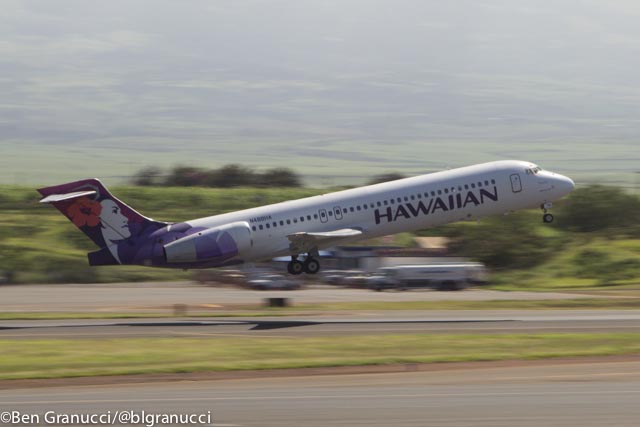
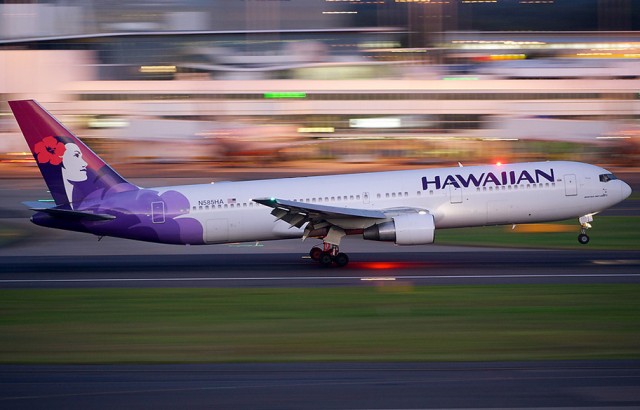
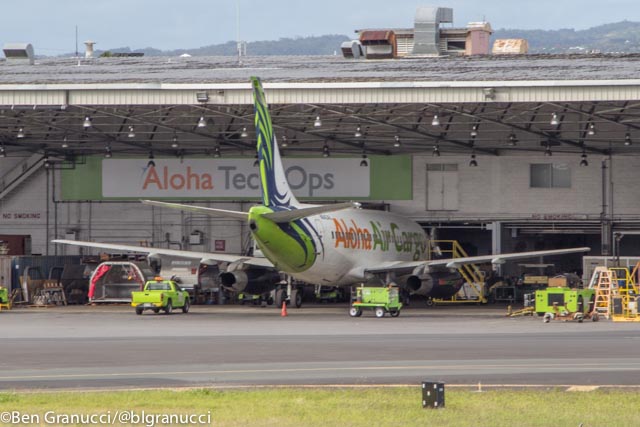
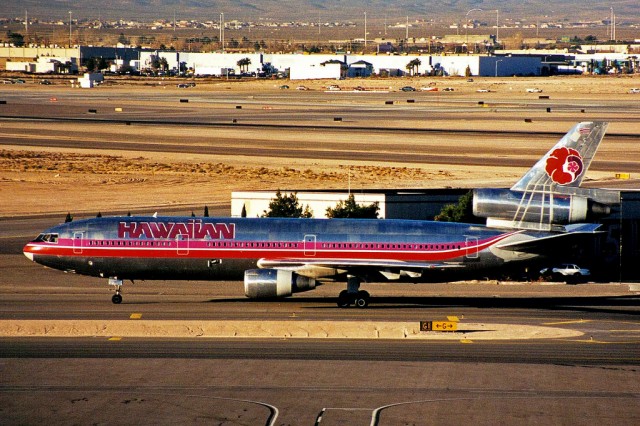
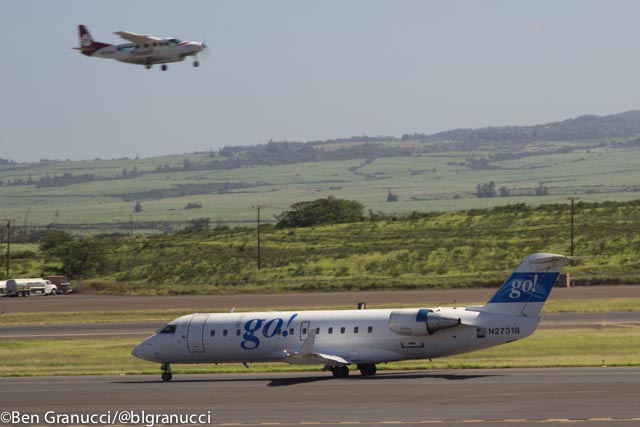
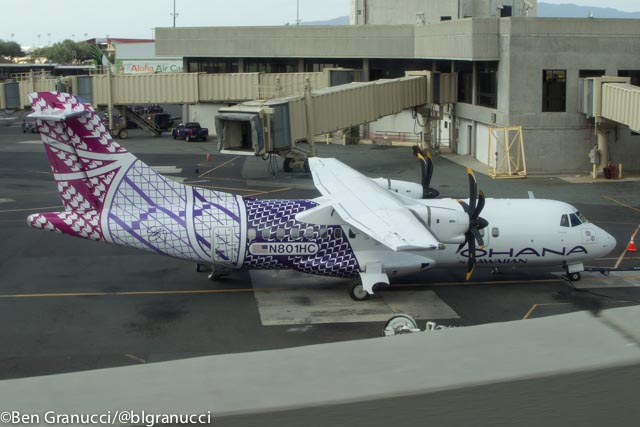
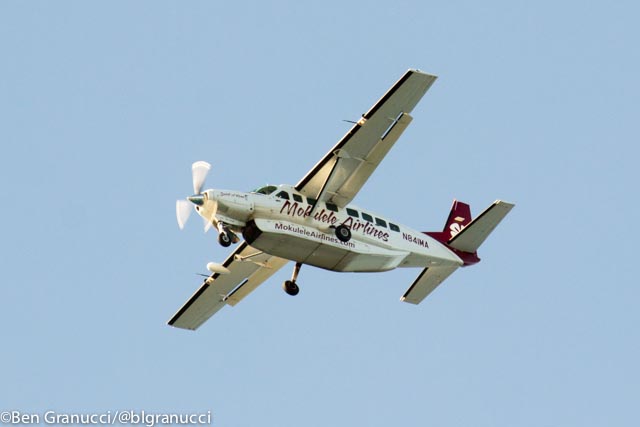
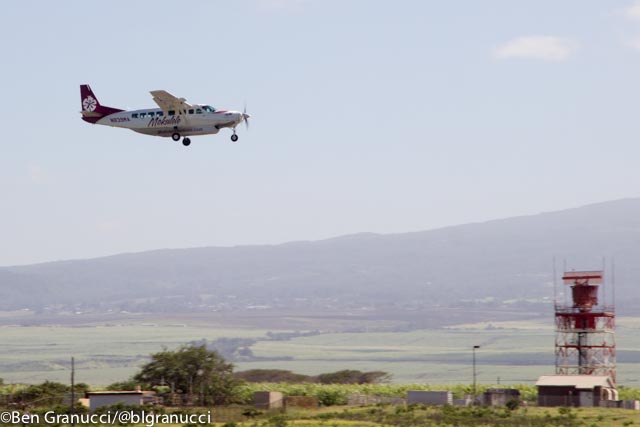
I think you mean Lihue (not Lanai) is one of the 5 major Hawaiian airports…
I was a little confused by that too.
I haven’t had the chance to fly Mokulele, but did fly an IslandAir Q200 in ’07 (HNL-OGG-KOA and back) and a Hawaiian 717 in ’04 (HNL-KOA and back). The service on Hawaiian was better, but you can’t beat a turboprop. 🙂
You missed some pretty major developments. No mention of the predatory nature of the go! incursion and it’s relationship to the failure of Aloha Airlines. Nor, the significant recent departure of go!.
Flying the Cessna caravans as a passenger flight in Hawaii is not a good idea. There have been a number of accidents caused by the loss of the single engine in those planes in Hawaii. The last one was in January of this year when the Caravan lost power and ditched off of Mauai. Luckily there was only one death. Also because that aircraft does not have retractable landing gear a water landing is questionable.
Don, That ditching in January with one death. That one death was the lady who “produced” Obama’s birth certificate. Go figure.
What took so long? go! was a ”no go” (no pun intended) from the start and the fact that they lasted eight years is a real mystery. I know that to the eyes of some, Go! is seen as responsible for the demise of Aloha Airlines. But this is really outside the realm of any possibility.
The basic formula for an airline to succeed is a strong capitalization and, particularly if they fly the same routes as their competitors, is to at least match their capacity and frequencies.
To cut fares to unrealistic levels is a straight road to disaster. Just imagine, even if go! put all their seat at minimum fares, all the competitors had to do was to match every single seat that go! had and still have plenty more to sell at a higher fare.
To be financially able to sustain their operation an airline must achieve e good balance between yield and load factor. With their small fleet of aircraft, their limited capacity and their fare structure kept unrealistically low, go! had neither. Their throwing in the towel was just a matter of time.
The real way for an airline to compete should not be by throwing into the market artificially low fares that smack more of an act of desperation than an intelligent marketing ploy. They should compete with prices that are affordable, sustainable and with the innovation, quality and reliability of their service. That is to say, healthy competition without dumping prices.
In 2006 go! started operations with five Bombardier CRJ-200 regional jet aircraft, competing against the 114 seats of Hawaiian Air B717 and the 148 seats of Aloha Airlines B737. The cost of operating the airline remotely from Arizona must have been prohibitive, the service for sure would have suffered. Also the scarce frequencies that such a small fleet allowed them to offer and, in case of mechanical failure, not having a replacement aircraft readily available to bring passengers to their destination quickly and efficiently, inspired anything but confidence in the airline. Then the chaotic attempts along the way, the aborted merger with Republic, the strange partnership with Mokulele using the double name and lately the rumor that Larry Ellison was interested in buying them (why?) added to the confusion and eroded the precious little confidence that the consumers may have had.
How did they last so long? Well, the demise of Aloha Air, although not of go!”s doing, helped them to keep barely alive, just on life support. But eventually they ran out of oxygen. It was inevitable.
But wherever there is a failure, an opportunity arises. Now is the moment for Island Air to come out of their shell and spread their wings. They are well capitalized and they could provide healthy competition for Hawaiian Air in the interisland market. I am sure that with their rapid international and mainland expansion, Hawaiian Air may even welcome additional capacity to the other islands.
Franco Mancassola
The author missed another significant fact in his report about Hawaii air service,
Discovery Airways:
Discovery Airways Inc.
Discovery Airways was founded by Franco Mancassola in 1988 .
The financial structure of Discovery Airways was as follows:
The seed capital ($1.4m) was provided by Franco Mancassola and Philip Ho, a Japanese citizen, naturalized American. Philip was also the President of Nansay Hawaii, a Japanese Real Estate Corporation that was developing Hotels and Golf courses in Hawaii.
As a working capital, Nansay Japan, provided Discovery Airways with $10 million in subordinated debentures to be repaid over 10 years at 10% interest. The reason for Nansay Japan”s financial participation was not to invest in Discovery Airways per se, but to secure sufficient air service between the Hawaiian Islands where Nansay had $1.8 billion invested in five star hotels and golf courses.
Discovery purchased 12 BAe 146-200 new aircraft. The value of the order was $328 million. The aircraft were financed by the manufacturer, British Aerospace, over a period of 25 years.
At that time the inter island air service was in the hands of a duopoly, Hawaiian Air and Aloha Air. Fares were high and service limited. Mancassola spotted the opportunity and proposed this venture to Nansay. Their gain was a sufficient air service between the islands to guarantee access to their hotels and golf courses.
However, Hawaiian and Aloha filed several objections with the US DOT, citing that British Aerospace (a UK corporation and Nansay, a Japanese corporation) by providing financial support (although in the form of debt) were exercising control over the airline, in violation of US law that limited the foreign ownership and control in US airlines, to a maximum of 25%.
The argument was flawed because debt does not constitute control. The DOT saw no foundations to Aloha and Hawaiian”s accusations and granted Discovery a provisional 401 license to operate. Discovery began operation on March 1st 1990.
Aloha and Hawaiian continued to object and in July 1990 obtained a recommendation from a Federal Judge for the DOT to withdraw the 401 certificate pending the results of an investigation as it was accused to be ”foreign”. In a ruling that was described ”highly unusual” Discovery”s certificate was temporarily suspended pending a future hearing. The airline, having been deprived of the working capital, was unable to go forward. This was really the political objective of both Aloha and Hawaiian Air.
On August 29th 1990 Franco Mancassola sold all his equity to Group Systems International and
resigned his position as Vice Chairman and Executive Vice President
Subsequently the investigation was dropped because there was no evidence of any wrongdoing on the part of Discovery and /or its management.
Single engine commercial service over “Blue Water” ought to be a No Fly Zone. There is no ETOPS and some of those flights are well beyond gliding distance to land. I won’t do it.
Good point, NFZ! I’m kind of surprised nobody uses King Airs for such a service out there!
Mike H.
Bullshit there is no compitator for this airline. It’s a monopoly. All the Gov’t Official are in thier PAYROLL. Island Air & mokolele are under thier pants they are controlled by this buying HAOLE.